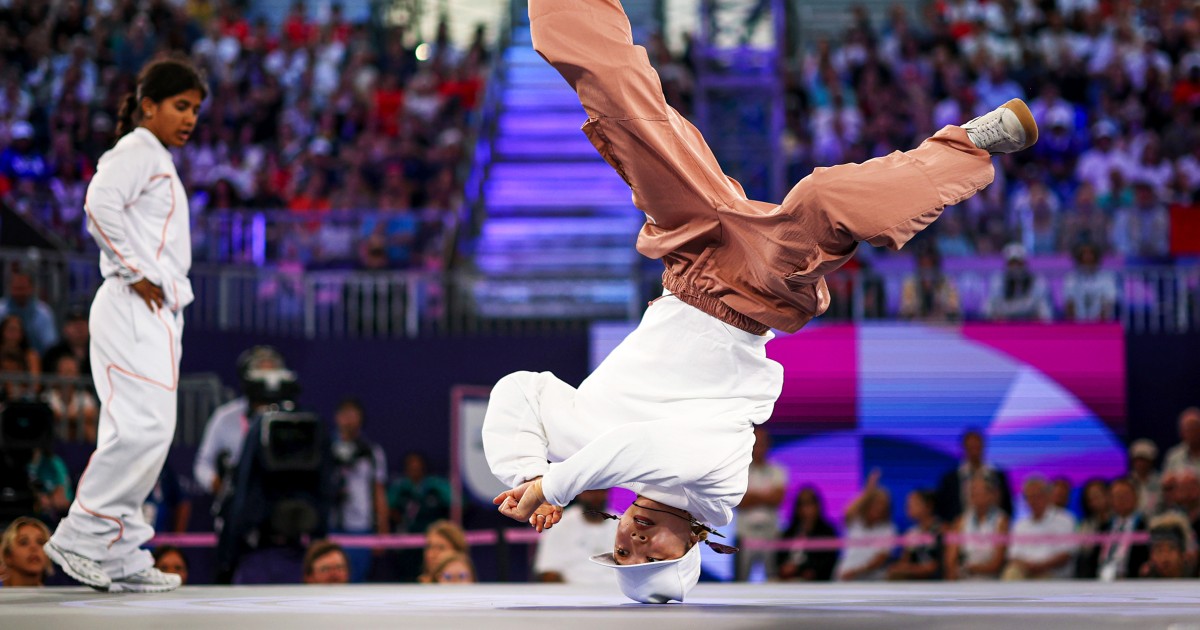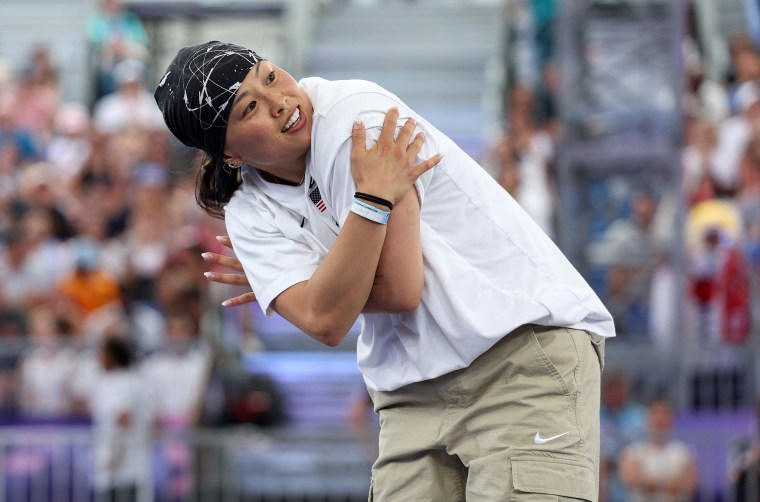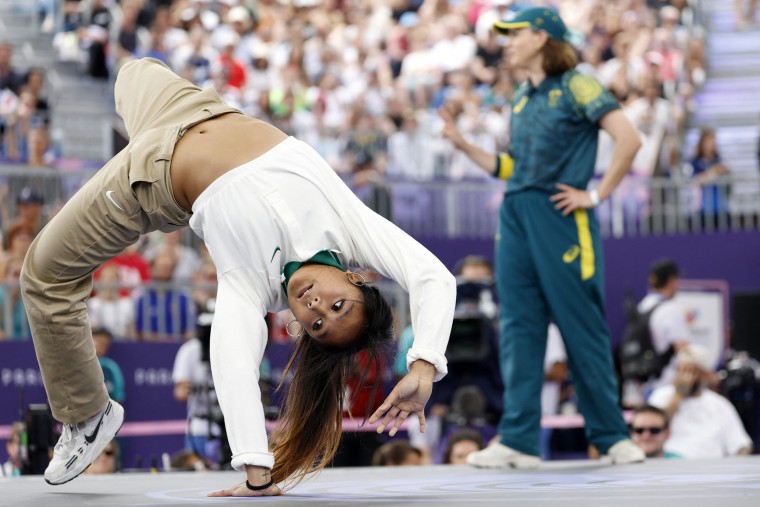Sports
Breaking explodes onto Paris’ La Concorde, exciting spectators in its first Olympic showing

PARIS — Friday night was a “powerful moment for hip hop” and a “powerful moment for dance,” as one of the first-ever Olympic breaking hosts put it after Japan’s Ami was crowned the winner of an arduous day of dance battles.
She faced off against Lithuania’s Nicka in the final, proving her worth and her standing entering the arena as a two-time breaking, or breakdancing, world champion.
Today, Ami added another medal to that list.
After they had finished breaking, and before they knew who won, Ami and Nicka embraced. And although the Japanese dancer won gold, there was a genuine sense of shared victory among the athletes, with the Lithuanian silver medalist holding her arms aloft, celebrating just as much as the victor, on this newfound stage for the discipline.
Even before crowds got into La Concorde, the majestic outdoor arena nestled in the heart of Paris, it was clear that something out of the Olympic ordinary was going down in this historic part of town.
Follow along for live coverage
Break beats reverberated down the Rue de Rivoli, while an MC could be heard whipping up the crowd into an excitable frenzy.
Inside the venue it was a scene like no other in Games history. A three-sided amphitheater looked down on a small stage where B-Girls faced off against each other in the first of two days of what is breaking‘s first — and perhaps only — Olympic showing.
It was a dismal showing for Team USA, though. Both its female competitors crashed out of the round-robin, unable to advance to the knockout stages to contend for a medal.
The result could be considered a shock, considering the sport originated in the Bronx neighborhood of New York City, but the women’s competition was fierce, featuring some upsets throughout.
A day of dance battles
The all-ages crowd was barely able to contain its unbridled joy throughout the round-robin, standing up in their seats and going wild each time a competitor landed a particularly technical move.
Friday’s semifinal was intense, with Ami besting the Netherlands’ India in the first battle, then Nicka pulling ahead against China’s 671 — the top seed.

The semifinal between 671 and Nicka could have been a final, with some simply breathtaking power moves and “down-rock” action that at times stretched the bounds of human physiology.
It looked like India — who had to battle in a pre-qualifier round to earn the 16th seed and enter the round-robin — might best Ami for some of their semifinal battle, but the judges ultimately awarded Ami two rounds to one.
The quarterfinal win from Nicka shook the temporary bleachers constructed on the cobbles of La Concorde, which started to sway ahead of the bronze medal battle.
With that victory, Lithuania’s national colors of red, green, and yellow surfaced among these seats in the form of flags, face paint and tie-dyed T-shirts throughout the three-sided bowl arena.
France’s two competitors didn’t make it past the quarterfinals. The first, Carlota, was out after the round-robin. Syssy, 16, was knocked out in the first quarterfinal against Ami, much to the dismay of the home crowd cheering her on.

Usually the Place de la Concorde is a busy traffic intersection. But for these Games it has been converted into a sprawling urban park, hosting not only breaking, but skateboarding, BMX and 3×3 basketball.
As so often is the case in these inter-city games, crowds are treated not only to the sports themselves but a jaw-dropping backdrop of historical landmarks, on this occasion La Madeleine church and the centerpiece of the Place de le Concorde itself, the Luxor Obelisk.
Summing up the good vibes Friday evening, one of the hosts, Malik, from France, told the crowd, “I want this day to last forever.”
A slow start for U.S. breakers
Paris is breaking’s Olympic debut, something that split the community of athletes who worried the official showing — complete with rules and points — would lose its hip-hop roots.
Its lack of inclusion in the L.A. 2028 Games has also caused some breakers to worry that the short showing on the world stage won’t be enough to fund the sport and truly support careers of professional breakers.
One of those breakers, Sunny, quit her day job in corporate America just to show in these Games. She didn’t medal today, making her future in the sport unclear.
Logistx was the other representative for Team USA on Friday, and also failed to earn a spot on the podium.

Despite a medal-less showing for the U.S., both Sunny and Logistx appeared delighted to be included in this history-making moment.
The sport’s lack of billing in the Los Angeles Games hit a sour note for fans as well, and it seemed clear from the mood Friday that breaking’s debut had been a success.
“Breaking is so fantastic because it’s freestyle and creative. It’s not like other sports,” said Ava Rodriguez, 44, who works as a data analyst in the French capital and “couldn’t believe” the sport wouldn’t be returning in the next Games.
The competitive yet collegiate spirit among competitors differentiated it from many other sports, she said.
“I love that they hugged at the end,” Rodriguez added. “It’s so good that we saw this tonight, and to see women doing it, too.”
Alison Palaia and Eric Quinlan grew up not far from New York City in the 1980s, just when breaking was becoming a thing in the Bronx.
“I remember kids in my school throwing down cardboard boxes on the floor and doing all of these moves,” said Quinlan, 50, now a software engineer who lives in Norwalk, Conn. “And so to see it at the Olympics all these decades later is just amazing.”
The married couple have become breaking fans since buying their tickets and said it lived up to their expectations.
“We’ve watched a lot of breaking over the past year, and that final was everything we hoped for,” said Palaia, 48, who works as an artist. “I love the way the athletes get in each others’ faces in a theatrical way, but then after they finished they were hugging and laughing. You can tell they all know each other.”
Like others, they are dismayed the sport won’t be in the next Olympics.
“We’re pretty bummed out about it, especially because breaking was invented in the U.S, in New York City,” she added. “I just hope they bring it back for the next one.”
It’s unclear whether the sport will reappear in a future Olympics, but fans have one more day to enjoy the twists, spins and freezes expertly preformed by the breakers.
On Saturday, USA’s B-Boys Victor and Jeffro will be among the athletes competing in the men’s try of Olympic breaking, wrapping the sport’s Paris showing.
Alexander Smith reported from Paris and Rebecca Cohen from New York City.










